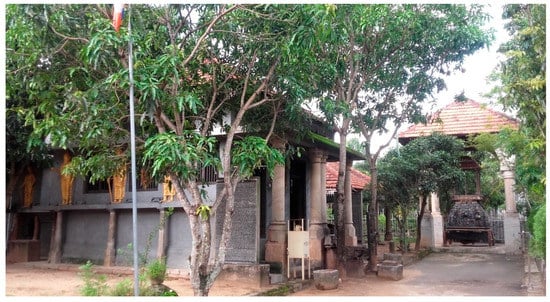in Two Annual Rituals at the Sri Devram Maha Viharaya in Pannipitiya, Sri Lanka
by Deborah de Koning, MDPI Religions, Netherlands, 21 August 2018

Figure 1 The Sri Lankesvara maha Ravana raja mandiraya (left side). This building is located at the premises of the Sri Devram Maha Viharaya. On the right side: one of the chariots for Ravana. This chariot is taken around in the annual perahera organized by this Buddhist temple. Picture taken by author, 6 June 2017.
https://www.mdpi.com/2077-1444/9/9/250
Reflections
…That the Ravana myth should not be considered a version of the Ramayana becomes for instance clear in the wall paintings of the Ravana mandiraya: These wall paintings concentrate on Ravana’s skills and the ancient Ravana civilization (also referred to as Hela civilization in the broader Ravana discourse). References to the Ramayana are also absent in the rituals for Ravana. Instead of a defeated Ravana as known from the Ramayana, the pride of the nation and the national identity (of the Sinhalese Buddhists)—which allegedly can be traced back to Ravana—is celebrated in the maha Ravana perahera.
This glorification of Ravana—who is turned into a legendary national hero of the Sinhalese-Buddhist majority—and his ancient civilization has to be understood in the context of increased assertiveness and nationalistic sentiments among the Sinhalese Buddhist majority in post-war Sri Lanka. Although not studied in detail, in the aftermath of the civil war (2009 onwards) a tendency similar to the post-independence period can be noticed among the Sinhalese-Buddhist majority: fostered by feelings of triumphalism there is an increase of feelings of majoritarianism, instead of the inclusion
of minorities.37
The glorification of an (imagined) ancient indigenous civilization in Sri Lanka is a way to express
feelings of triumphalism and superiority over minorities. Lanka belongs to the Hela and the Hela are
considered the ancestors of the Sinhalese. The recently invented rituals performed for Ravana at the
Sri Devram Maha Viharaya and the broader efforts undertaken in the Ravana discourse have to be
understood in this context: to help create an image of a glorious past. As also pointed to in this article,
in the rituals a connection with the present is made. In the contexts of both rituals, references are
made to power—not just of Ravana—but also of the nation (of the Hela or Sinhalese). In speeches and
comments the audience is addressed to as born from Ravana’s blood. Both the rituals and the speeches
are thus stimulating the audience to awaken a sense of the strong (imagined) heritage of Sri Lanka and
a pride of being Sinhalese.